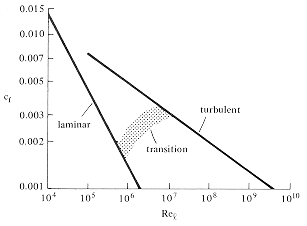|
The
interaction between the flat plate and the flow can be expressed in terms
of a friction coefficient that will be different in the laminar and turbulent
flow regimes. By analogy with solid friction, the coefficient, Cf,
is the friction force per unit area divided by the normal force due to
the dynamic pressure of the fluid. This quantity can be expressed in terms
of the Reynolds number so that in the laminar region,
Cf = 1.33 (Re)-0.5,
and in the turbulent region:
Cf = 0.074 (Re)-0.2.
These quantities are shown in the logarithmic plot opposite which also
indicates the range of the transition region between the two limiting flow
types.
From
the point of view of skin friction laminar flow is a clear advantage. As
will be seen in the following discussion, turbulent flow can sometimes
provide an overall drag advantage because of its effects on the pressure
distribution around a vehicle. In these cases, the increased skin friction
drag is more than compensated for by the reduced pressure drag. |
|
|
|
|
|
|
|
|
|
|
|
|
